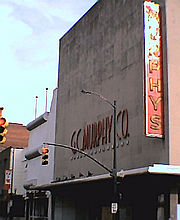
G. C. Murphy
Encyclopedia

Five and Dime
Five and Dime is a cartoon short by Walter Lantz which features Oswald the Lucky Rabbit. It is the 74th Oswald short produced by Lantz and the 125th overall. It also is among the number of shorts that feature Oswald in his fully clothed appearance....
or variety stores in the United States
United States
The United States of America is a federal constitutional republic comprising fifty states and a federal district...
.
Origins of chain
The chain was founded in 1906 in the Pittsburgh suburb of McKeesport, PennsylvaniaMcKeesport, Pennsylvania
McKeesport is a city in Allegheny County, Pennsylvania, in the United States; it is located at the confluence of the Monongahela and Youghiogheny rivers and is part of the Pittsburgh Metro Area. The population was 19,731 at the 2010 census...
, by George Clinton Murphy. Murphy had gotten his start in retail as a manager of a McCrory's store in 1896. Murphy later moved to Detroit, Michigan
Detroit, Michigan
Detroit is the major city among the primary cultural, financial, and transportation centers in the Metro Detroit area, a region of 5.2 million people. As the seat of Wayne County, the city of Detroit is the largest city in the U.S. state of Michigan and serves as a major port on the Detroit River...
, to manage several stores there, and then returned to the Pittsburgh, Pennsylvania
Pittsburgh, Pennsylvania
Pittsburgh is the second-largest city in the US Commonwealth of Pennsylvania and the county seat of Allegheny County. Regionally, it anchors the largest urban area of Appalachia and the Ohio River Valley, and nationally, it is the 22nd-largest urban area in the United States...
, area to launch his own stores. His namesake chain was founded in 1906. It was one of several large retailers to originate in Pennsylvania. http://www.gcmurphy.org/history.html
Murphy died in 1911, five years after the launch of the chain. Two former McCrory's executives, John Sephus Mack
John Sephus Mack
John Sephus Mack , was president of the G. C. Murphy Company, a prominent variety-store chain during the early 20th century....
and Walter C. Shaw, bought the G.C. Murphy chain, which was at the time about 12 stores, that same year. The chain quickly expanded both through new stores and purchase of competitors.
Overview of features
Murphy's stores became popular in part because of their locations; many locations were in small and medium sized towns that had previously been served only by stores owned by whatever mining company was based there. The lunch counters in the stores were a popular destination for quick and inexpensive meals (prior to the rise of the fast food chain). Murphy's stores were designed in house and to a high standard, led by architects like Harold Ellsworth CrosbyHarold Ellsworth Crosby
Harold Ellsworth Crosby was an American architect who supervised the construction of many G. C. Murphy Co. discount department stores across the United States. Born in Maryville, Missouri, he graduated from Iowa State College with a B.A., 1922...
.
The store's merchandise was also accessible and inexpensive, and like several other chains at the time, Murphy's became profitable by offering these low-priced items. The company remained profitable even during the Great Depression
Great Depression
The Great Depression was a severe worldwide economic depression in the decade preceding World War II. The timing of the Great Depression varied across nations, but in most countries it started in about 1929 and lasted until the late 1930s or early 1940s...
.
Growth and expansion
The chain began testing larger store concepts; in 1955, it opened several locations in shopping centers. In 1970, it opened its first large scale store, branded as "Murphy's Mart". The stores were similar in size and concept to KmartKmart
Kmart, sometimes styled as "K-Mart," is a chain of discount department stores. The chain acquired Sears in 2005, forming a new corporation under the name Sears Holdings Corporation. The company was founded in 1962 and is the third largest discount store chain in the world, behind Wal-Mart and...
, and were often located in suburbs. By 1976, the G.C. Murphy Company had grown to 529 stores.
Changes and suspension of business
In 1985, the company was acquired by Ames Department Stores Inc. Ames rebranded many of the larger "Murphy's Mart" stores. In 1989, Ames decided to sell the variety stores (while retaining the former Murphy's Mart), and sold the division to the McCrory's chain led by Meshulam Riklis. McCrory's rebranded some and closed others. The McCrory's chain filed for bankruptcy in 1992, closed many of their stores (including former G.C. Murphy's outlets) in 1997, and ceased any and all operations in 2001.Current activities
Although the stores ceased business operations some time ago, the chain's foundation, the G.C. Murphy Foundation, is still in existence. Retirees and former employees of the stores have a volunteer organization that allows them to keep in touch.In 2005, the Pittsburgh Post-Gazette reported that the Murphy Foundation had commissioned a writer to compile the G.C. Murphy Company's history. That history, titled For the Love of Murphy's: The Behind-the-Counter Story of a Great American Retailer, by Jason Togyer, was published in 2008 by Pennsylvania State University Press.

